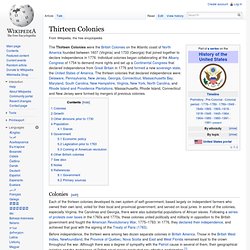

Hands On History: Colonial Cooking. N ew A msterdam Hutspot Hutspot is traditionally eaten by the citizens of the Dutch city Leyden each year on the 3rd of October. Eating this delicious traditional Dutch meal celebrates the courage of the inhabitants of Leyden who withstood a seven month siege by the Spanish army. Holding out against all odds, and suffering great hardship, the deliverance of Leyden was key in winning Dutch freedom from Spain in 1581. 2 pounds fresh beef brisket 4 ccups water 2 teaspoons salt 3 pounds potatoes, peeled and cut in quarters (6 potatoes) 2 cups sliced carrots 1 1/2 cups chopped onions 2 tablespoons butter 1/3 cup cold water 3 tablespoons flour In a 4-quart Dutch oven combine beef brisket, 4 cups water and salt.
Back to top. Recipes - 13 Colonies. Food and Population. Farmers are invisible people, and middle-class city dwellers choose to pretend that the long lines of trucks bringing food into the city at dawn every day have nothing to do with the white-collar world.

Perhaps it is a mark of the civilized person to believe that the essentials of food, clothing, and shelter have no relevance to daily life. Yet if the farmers stopped sending food into the great vacuum of the metropolis, the great maw of urbanity, the city would soon start to crumble, as Britain discovered in the year 2000 [5]. The next question, then, is: Where does all this food come from? Is there such a thing as sustainable agriculture, or is “sustainable agriculture” a self-contradictory term? To keep a piece of land producing crops, it is necessary to maintain a high level of various minerals.
The native people of North America had a simple solution: abandonment [3]. Writing early in the twentieth century [4], F.H. But these two forces do not act merely in a circular fashion. 1. Www.jwu.edu/content.aspx?id=61519. Just like our hands-on learning labs, our library offers personalized, dynamic resources to make the most of your time at JWU.

Take advantage of our unique assets, which range among our campuses from interactive text reference service to flexible study arrangements, from writing and research training workshops to an extensive collection of local university books and resources. Visit our Providence, North Miami, Denver and Charlotte Campus libraries. Study ResourcesUse our personalized guidance and services, which include: Wi-Fi, computers, printers and photocopiers Group study roomsIndividual research consultations with our librarians Workshops/instruction on library resources, writing papers and more Flexible seating arrangements for group projectsText and IM virtual reference service (ask us about research, hours, requesting books, anything!)
Thirteen Colonies. The Thirteen Colonies were the British Colonies on the Atlantic coast of North America founded between 1607 (Virginia) and 1733 (Georgia) that joined together to declare independence in 1776.

Individual colonies began collaborating at the Albany Congress of 1754 to demand more rights and set up a Continental Congress that declared independence from Great Britain in 1776 and formed a new sovereign state, the United States of America. The thirteen colonies that declared independence were: Delaware, Pennsylvania, New Jersey, Georgia, Connecticut, Massachusetts Bay, Maryland, South Carolina, New Hampshire, Virginia, New York, North Carolina, and Rhode Island and Providence Plantations.
Massachusetts, Rhode Island, Connecticut and New Jersey were formed by mergers of previous colonies. Colonies[edit] Growth[edit] North American colonies 1763–76, illustrating and territorial claimsIn 1775, the British claimed authority over the red and pink areas on this map and Spain claimed the orange.